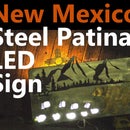Introduction: GIANT Steel Chiminea Firepit
This Steel Chiminea was designed to be a statement piece in a new restaurant. We designed it out of 12ga Hot Rolled Steel which sounds thin (just under 1/8") but will easily handle a strong fire. Better yet, the intended use of the chiminea is to smolder Pinion Wood, which makes an amazing smell to help set the ambiance of the outdoor seating area.
Step 1: Plasma Cutting
We used a plasma cutting CNC table to cut out our parts, but this would be pretty easy to do with just a grinder as all the lines are straight and reference off of other parts of the build. In fact I've included FREE DXF cutting files and hand cutting plans here.
Plasma cutting is somewhat like laser cutting except not as 100% accurate and uses Ionized compressed gas (plasma) to heat and cut the steel rather than focused light.
After each piece was cut, my helper ground off any cutting dross (like tearout on a tablesaw) with a grinder using a wire wheel and flap disk.
Step 2: Tack Up
Once we adjusted the welder to approximately 21 volts, 450 IPM we got to doing a first assembly. Each piece is held in place and connected to its neighbors with tacks, or small welds that can be easily removed if needed. We also took advantage of my metal worktable by tacking the bottom of the piece to the table to hold it in place.
Step 3: Buttoning Up
Wow, look at the scale of this thing. It was very convenient that my helper could stand inside it while we tacked in the last piece. In the video you'll see how wobbly it is!
That sounds scary but welding sparks are VERY small particles and do not carry much heat. The 100% cotton shirts combined with the welding helmets protect us from 99%+ of all itty bitty burns.
Step 4: Bottom Plates
The Chiminea has a lower wood storage compartment and an upper firebox. Each needed a square cut out, again on the plasma table, then welded in. We opted to take exact measurements.
The bottom plate for the wood storage was attached with about 15 tacks per side so rain water could drain out where the bottom met the sides.
We also elevated it about 1/4" off the ground to make the pit more stable.
Step 5: Firebox
The firebox went much like the wood storage compartment in that we measured before cutting. For attachment we used five 2" long stitch welds, or short, normal welds, to attach it as they're much stronger but rainwater could still drain through the gaps.
Step 6: Finish Welding
With the giant beast tipped on its side I started welding. Because we took our time in the initial fit up, the gaps between metal plates were small, so the welding was easier.
I set the machine about 5% lower than I normally would and welded the whole joint in as straight of a pass as I could. Doing so gives you a stronger joint and makes grinding easier later on.
If you're just starting out with welding, I would tip the whole chiminea 45 degrees and weld on a flat joint (corner pointing to the sky) as that is an easier starter's weld.
Step 7: Grinding
The joints were then ground smooth, which isn't even necessary depending on the look you want. We first used a large 11" grinding disk to knock down most of the weld beads, then switched over to a 4.5" flap disk, which is like layers of sandpaper in a spiral.
The flap disk let us get a flat, smooth finish you could run your hand over without getting a scratch.
Step 8: Delivered!
The customer was super happy and so were we!
I can't wait to see this when the outdoor seating goes in place.
If you want to see the MAJOR hiccup that happened along the way, check out the youtube video:

Runner Up in the
Backyard Contest











